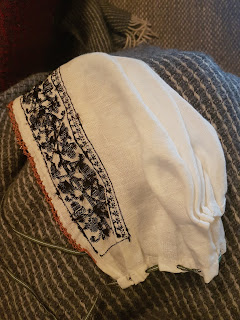The
medieval tradition of covering the hair with a haube, a hood, as a
sign of marital status continued during the 16th century. In the first years of the century the headwear was quite plain, mostly just white linen. But smaller embroidered ribbons with late gotic patterns started to appear and soon the embroidery on the haube could be quite large.
When I made my last embroidered haube, to be found here, I though it would take longer before I made another one. But this summer I spend a lot of time in my summerhouse and needed something small to bring with me, and that was an embroidery. So when the summer was over I had a finished piece of embroidery, fit for a haube. It was quite wide, and long, so, a haube or a brustfleck. And I dont have a suitable dress for a brustfleck yet, so therefore, haube!
Its made with cross stitch in black silk on white linen.
The pattern for the main part was published in patternbooks 1579, 1582, 1586, 1588, 1589, 1596, 1598, and 1600. I used a portrait as long going inspiration for this piece, but its not the same pattern, just very alike. Its Portrait of an old lady by Nicolas Neufchatel from 1562. Here is her embroidered haube.
She wears a smaller wulst, the development of the headwear saw a reduction in size after the first decade of the 16th century. Later the wulst also started to lean a bit backwards, and this lady wears a haube that is an example of that. Mine is not that big, but a little bit to round to be 1560. Its more like 1510-20 in its form. On top of her wulsthaube she wears what I interpret as a haube, a cap, not a veil.
For the outerparts I made the pattern up myself. Hers are more of little bugs, mine are more like little trees.
Geometrical
patterns (late Gotic) was common during the first part of the 16th
century to be replaced by softer more natural forms (early
Renaissance). Flowers
where common motifs. Mine is a typical early renaissance pattern.
This is when I was making the pleats in the back. They are secured with just one stitch in the back, attached to the straight back piece. Holes are then made in the sides to make a drawstring.
The woman in the painting has spangles around her forehead. The technique holding the spangles could be needle lace. Needle lace is as an example used on the upper part of the Lengberg bra from the 15th century. My needle lace is made of pink handdyed silk. I could´nt figure out how the lace in the painting was done so I made my own. The inspiration for the pattern of the needle lace is from the Lengberg bra dress. It was the first time I tried to make needle lace and I struggled with the tension.
I also made the spangles myself. A friend of mine made me tools for spanglemaking earlier this year and this is the first time I have used them on a garment. They are punched out of a silver sheet.
On the top of embroidered haubes there are almost always a thin silk layer, to protect the embroidery I assume. So far I have not seen a painting of an embroidered haube without that covering layer.
So, I made a haube, again, for a dress I dont have. Embroideries like these where not for everyone. Silk
was a status symbol for the wealthiest people in society. The quality
of the fabric was a indicator of the status of the wearer. It was forbidden by law to dress above your class. It was a narrow social class that could purchase and wear
this exclusive commodity. Silk-, gold-
and pearlwork were restricted to the upper-classes. And here I used both a lot of silk and also silver.
Source for needle lace:
https://www.academia.edu/7179007/One_Thread_Three_Techniques_Needle_Lace_Fingerloop_Braided_Laces_and_Sprang_at_Lengberg_Castle_East_Tyrol
Pattern:
https://www.metmuseum.org/art/collection/search/352225?searchField=All&sortBy=relevance&when=A.D.+1600-1800&ft=pattern+book&offset=380&rpp=20&pos=381














I just love the needle lace with spangles look.
SvaraRaderaThank you =) The face-framing effect turned out really nice with the needle lace I think!
Radera